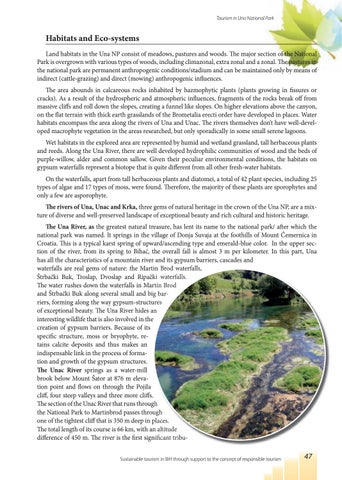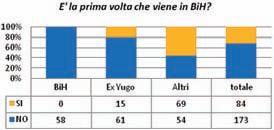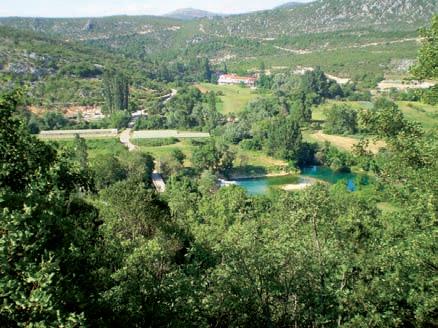Tourism in Una National Park
Habitats and Eco-systems Land habitats in the Una NP consist of meadows, pastures and woods. The major section of the National Park is overgrown with various types of woods, including climazonal, extra zonal and a zonal. The pastures in the national park are permanent anthropogenic conditions/stadium and can be maintained only by means of indirect (cattle-grazing) and direct (mowing) anthropogenic influences. The area abounds in calcareous rocks inhabited by hazmophytic plants (plants growing in fissures or cracks). As a result of the hydrospheric and atmospheric influences, fragments of the rocks break off from massive cliffs and roll down the slopes, creating a funnel like slopes. On higher elevations above the canyon, on the flat terrain with thick earth grasslands of the Brometalia erecti order have developed in places. Water habitats encompass the area along the rivers of Una and Unac. The rivers themselves don’t have well-developed macrophyte vegetation in the areas researched, but only sporadically in some small serene lagoons. Wet habitats in the explored area are represented by humid and wetland grassland, tall herbaceous plants and reeds. Along the Una River, there are well developed hydrophilic communities of wood and the beds of purple-willow, alder and common sallow. Given their peculiar environmental conditions, the habitats on gypsum waterfalls represent a biotope that is quite different from all other fresh-water habitats. On the waterfalls, apart from tall herbaceous plants and diatomei, a total of 42 plant species, including 25 types of algae and 17 types of moss, were found. Therefore, the majority of these plants are sporophytes and only a few are asporophyte. The rivers of Una, Unac and Krka, three gems of natural heritage in the crown of the Una NP, are a mixture of diverse and well-preserved landscape of exceptional beauty and rich cultural and historic heritage. The Una River, as the greatest natural treasure, has lent its name to the national park/ after which the national park was named. It springs in the village of Donja Suvaja at the foothills of Mount Čemernica in Croatia. This is a typical karst spring of upward/ascending type and emerald-blue color. In the upper section of the river, from its spring to Bihać, the overall fall is almost 3 m per kilometer. In this part, Una has all the characteristics of a mountain river and its gypsum barriers, cascades and waterfalls are real gems of nature: the Martin Brod waterfalls, Štrbački Buk, Troslap, Dvoslap and Ripački waterfalls. The water rushes down the waterfalls in Martin Brod and Štrbački Buk along several small and big barriers, forming along the way gypsum-structures of exceptional beauty. The Una River hides an interesting wildlife that is also involved in the creation of gypsum barriers. Because of its specific structure, moss or bryophyte, retains calcite deposits and thus makes an indispensable link in the process of formation and growth of the gypsum structures. The Unac River springs as a water-mill brook below Mount Šator at 876 m elevation point and flows on through the Pojila cliff, four steep valleys and three more cliffs. The section of the Unac River that runs through the National Park to Martinbrod passes through one of the tightest cliff that is 350 m deep in places. The total length of its course is 66 km, with an altitude difference of 450 m. The river is the first significant tribuSustainable tourism in BiH through support to the concept of responsible tourism
47







